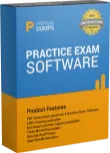
Get AAPC CPC Exam Dumps
AAPC Certified Professional Coder (CPC) Exam Dumps
This Bundle Pack includes Following 3 Formats
Test software
Practice Test
Answers (PDF)

CPC Desktop Practice
Test Software
Total Questions : 100

CPC Questions & Answers
(PDF)
Total Questions : 100

CPC Web Based Self Assessment Practice Test
Following are some CPC Exam Questions for Review
View MR 003396
MR 003396
Operative Report
Preoperative Diagnosis: Acute MI, severe left main arteriosclerotic coronary artery disease
Postoperative Diagnosis: Acute MI, severe left main arteriosclerotic coronary artery disease
Procedure Performed: Placement of an intra-aortic balloon pump (IABP) right common femoral artery
Description of Procedure: Patient's right groin was prepped and draped in the usual sterile fashion. Right common femoral artery is found, and an incision is made over the artery exposing it. The artery is opened transversely, and the tip of the balloon catheter was placed in the right common femoral artery. The balloon pump had good waveform. The balloon pump catheter is secured to his skin after local anesthesia of 2 cc of 1% Xylocaine is used to numb the area. The balloon pump is secured with a 0-silk suture. The patient has sterile dressing placed. The patient tolerated the procedure. There were no complications.
What CPT coding is reported for this case?
A 6-French sheath and catheter is placed into the coronary artery and is advanced to the left side of the heart into the ventricle. Ventriculography is performed using power injection of contrast agent. Pressures in the left heart are obtained. The coronary arteries are also selected and imaged.
What CPT code is reported?
A business requires drug testing for cocaine and methamphetamines prior to hiring a job candidate. A single analysis with direct optical observation is performed, followed by a confirmation for cocaine.
Which codes are used for reporting the testing and confirmation?
A 5-year-old who has an allergy history experienced a possible reaction to peanuts. A quantitative, high-sensitive fluorescent enzyme immunoassay was used to measure specific IgE for recombinant peanut components. Results showed there was no reaction indicating the child has a peanut allergy.
What lab test is reported?
A physician prescribes carbamazepine to treat a patient with epileptic seizures. After six months, the physician performs a therapeutic drug test to monitor the total level of the drug in the patient.
What CPT and ICD-10-CM coding is used for the six month-evaluation?
Unlock All Features of AAPC CPC Dumps Software
Types you want
pass percentage
(Hours: Minutes)
Practice test with
limited questions
Support